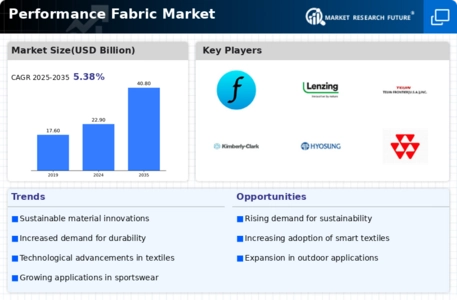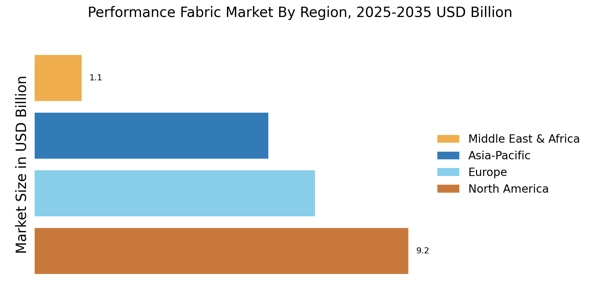Sustainability Initiatives
The increasing emphasis on sustainability within the Performance Fabric Market is driving innovation and demand. Manufacturers are increasingly adopting eco-friendly materials and production processes to meet consumer expectations for environmentally responsible products. This shift is evidenced by a reported 20% increase in the use of recycled materials in fabric production over the past three years. As consumers become more aware of environmental issues, the demand for sustainable performance fabrics is likely to grow, influencing purchasing decisions across various sectors, including apparel, automotive, and home furnishings. Companies that prioritize sustainability may gain a competitive edge, as they align with the values of a more environmentally conscious consumer base.
Technological Advancements
Technological advancements play a crucial role in shaping the Performance Fabric Market. Innovations in textile manufacturing, such as the development of moisture-wicking, stain-resistant, and UV-protective fabrics, are enhancing the functionality and appeal of performance textiles. The market has seen a notable increase in the adoption of advanced manufacturing techniques, including 3D knitting and digital printing, which allow for greater customization and efficiency. According to recent data, the market for smart textiles, a subset of performance fabrics, is projected to grow at a compound annual growth rate of 25% over the next five years. This trend indicates a strong consumer interest in high-performance fabrics that offer enhanced features.
Growth in E-commerce and Online Retail
The rise of e-commerce and online retail is significantly impacting the Performance Fabric Market. With the increasing convenience of online shopping, consumers are more inclined to purchase performance fabrics and related products through digital platforms. Recent statistics reveal that online sales of performance apparel have grown by approximately 40% in the last year alone. This trend is encouraging brands to enhance their online presence and invest in digital marketing strategies to reach a broader audience. As e-commerce continues to expand, companies that effectively leverage online channels may experience accelerated growth and improved market penetration.
Customization and Personalization Trends
Customization and personalization are becoming increasingly important in the Performance Fabric Market. Consumers are seeking unique products that reflect their individual styles and preferences. This trend is prompting manufacturers to offer customizable options, such as personalized prints and tailored fits, which enhance consumer engagement and satisfaction. Recent surveys indicate that nearly 60% of consumers are willing to pay a premium for personalized products. As a result, brands that embrace customization strategies may not only enhance customer loyalty but also differentiate themselves in a competitive market. This shift towards personalization is likely to shape product development and marketing strategies in the coming years.
Rising Demand in Sports and Outdoor Activities
The Performance Fabric Market is experiencing a surge in demand driven by the growing popularity of sports and outdoor activities. As more individuals engage in fitness and recreational pursuits, the need for high-performance apparel that offers durability, breathability, and moisture management is increasing. Market data suggests that the sports apparel segment is expected to account for over 30% of the overall performance fabric market by 2026. This trend is further supported by the rise of athleisure, where consumers seek versatile clothing that can transition from workout to casual wear. Brands that effectively cater to this demand may find substantial growth opportunities.


















Leave a Comment